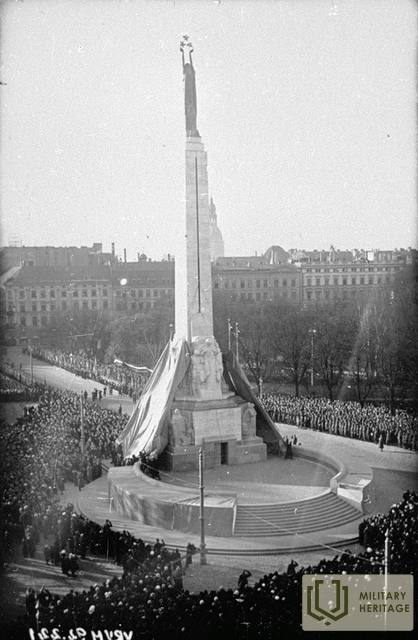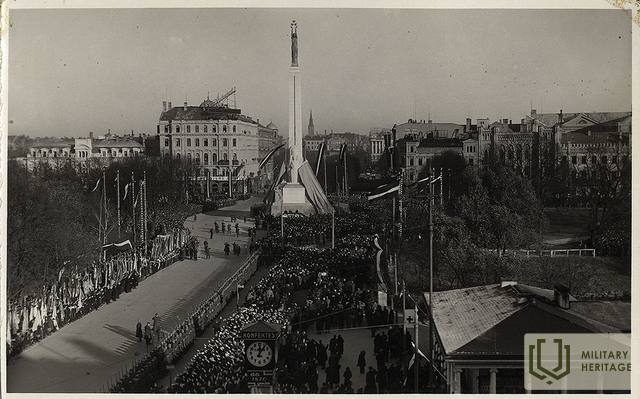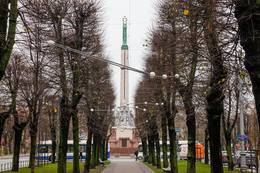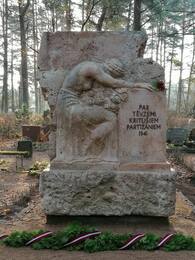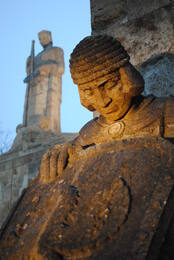Kārlis Zāle ja vabadussammas
The narrator describes Kārlis Zali as a personality who created the most famous works of Latvian art. The description is dedicated to the commemoration of the hall in 1942 (the year of K. Hall's death). The memories have been chosen to describe K. Zāle's works based on the author's personal qualities and perception of the world.
“(..) In the course of life and work, the personality of the Hall has developed from its inner center. The hall is one of those people with whom you could immediately feel the inner core, which is important. This core lay in his vitality. the innate forces, the legacy of the course ancestors, is the great dowry that Laima placed in the cradle of the son of Course. Nature had endowed the Hall with wasteful nature. The tireless liveliness flowed on the sculptor's floor, in every gesture, in the expressive play of features and in the language, giving everything a special freshness and juiciness. His fantasy sparkled briskly and spontaneously from the fertile vital layer. From here came all that was original and healthy primitive in the life and work of the Hall. This unspoiled stockpile of peasant forces broke through the way and overcame adversity. In creative work, it provided an opportunity to say something of our own and something new, to stand out in the first place, gaining outstanding achievements in our monumental sculpture. In this region of art, we did not have our own traditions grown in the circle of modern culture, which began to develop in the region of Latvian painting since the end of the last century. In this way, we could easily submit to the influence of the ancient cultural peoples, remaining imitators and descendants. "If this did not happen, if in a relatively short time our best sculptors could create something unique and remarkable in the field of monumental sculpture, it is due to the rustic foundation of our lives. This ancient layer is expressed by Zāle with deep and instinctive security. could grow from the roots of rustic fresh primitiveness, looking beyond the ancient wisdom and beauty of today's cultural decoration in its - I would say - barbaric splendor and grandeur ... '
"(..) We, the master said, do not have to be ashamed and run away from ourselves and the time we stand, but we must be who we are - Lat public artists. If you are an artist, show the power of your land, its blessings and beauty, show the workers in their efforts, show the mothers of the guardians of the family, the guardians of the fatherland, show it all with dignity, warm feelings and reverence for others to see who we are , and we could be respected. But if thou make thy faces perverse in thy foolish countenance, and smite the face of the peasants and of the laborers with mud, and make them like crippled beasts, and show them as slaves and criminals? . It doesn't hurt to throw away your brushes and go digging ditches or do some other useful work. How can others respect you if you can't respect yourself? Being an artist does not mean slipping through life and random details, but it means looking for the core and the nucleus in nature and in people. The dilettante sticks to random details and does not see the main thing, but the other dilettante jokes with the form and rejoices as if about happy coincidences. If I spit, my spit will sometimes erupt with unknown twists and drops, but can it be approached by a serious artist for his art? This is done only by dilettante pawns, who show off their nonsense, but not by serious painters. Gentleman and dilettante - those words were bitter and despicable in the mouth of the Hall. The sculptor also did not respect light improvisation and empty excitement in art. Especially in the last stages of his life, Hall increasingly emphasized the importance of knowledge and true ability, skills and mastery. He highly respected the traditions of academic art. At the same time, at the meeting of the Brothers' Cemetery Committee, the sculptor refuted the academician F.'s objections that the horse floors he created were not in the right proportions. The hall then had the ring brought in and measured that everything was in line with recognized norms. F. then felt purely awkward. I remember that when showing the photos from the works of the masters of the academic field in the Luxembourg Museum, the Hall was happy: “What knowledge and skill here! It is immediately clear what the master wanted to achieve. There are proportions, understanding of the formation of forms, a sense of beauty. Such works will still retain their value and will not get tired. But with us, some good ones imagine in their incompetence and unpreparedness that we make great works of art. "(..)"
“(..) On the one hand, Zāle paid attention to serious studies of form, understanding of movements and anatomical structure, but on the other hand, he focused on composition. For students who have already imagined we are ready-made artists who are allowed to do as they please, Zāle simply told them not to waste time here at the academy. The profession of sculpture must be studied at the academy, knowledge and art must be acquired. It is very good to do what everyone likes and what comes to mind at home. With great enthusiasm, Professor Zāle was able to approach the students without suppressing their individual perception, but finding out what to do and how to approach their task. For the first time, many people opened their eyes and the favorable results could be seen in an exhibition of students' works in a short time. The hall delved into the meaning of the composition, the structure of forms, the movement of figures, expression and characterization. When the student had realized what to look for in a certain essay, the study of strict natural forms took on a completely different meaning. In this way he taught the students to consciously control their formation, but not to make no sense to simply copy the visibility of nature (...) ”
"(..) He took part in the design competition for the Freedom Monument in 1924 and 1925. In 1925, the Cabinet of Ministers decided that the Freedom Monument should be erected after the Hall, but this decision was not implemented. There was a lot of intrigue and noise going on around these years, but there was no definite positive outcome. However, the competition, like the work of the Brethren's Cemetery, played an important role in the development of the Hall. He gained considerable experience, got a lot to consider and think about, to find out his ideas, which could later be put into practice. The master and some of his closest friends had their own meeting place in the city • - at Madernieka, Brīvības Street 13. Here, collaborators also gathered, as this was the home of this artists' association. There, the events and artistic issues of the day were discussed in detail; wrote or discussed some good articles. There was a "headquarters" here, where the situation was discussed during the monument competition, rejoicing in success and flirting with failures. The issue of the monument was abandoned in 1930. The last competition for the design of the monument took place in 1930, when the hall won the first prize. At that time, a high barracks - a workshop with bright windows - rose on the monument's square. The chisels of many stonemasons and craftsmen were knocked both on the ground and on the platforms. alti, tearing the solid granite mass. It was like a strange country of fairy tales, where the creator's will to immerse and remain in matter was seen in the spirit. Sunlight shone in the armchair of the spacious rooms, and the white floors of the giants gleamed in it, everyone waiting for the moment of their fulfillment in a quiet solemnity. There were scattered blocks of stone all around with arranged parts: arms, waist, heads, a true membrane di- siecta - as the Latin poet says. These impressions remained indelible in the workshop. The Freedom Monument was made. In the meantime, the hall had acquired a house on Avotu Street. Its income was to support the existence of the master and his family in order to be able to live and work independently in the future, as the artist's intentions were rich and extensive (...).
“(..) The past and the present are included in the Freedom Monument as one indivisible song in the sounds of heroism. In the great breath it expresses the whole life of the people: work, search for the spirit, family, military power; Lāčplēsi - a performer of the savage forces, a singer-vaideloti; the shackles of slavery and the image of Freedom with shining three stars are also opened by historical scenes. The wonderful light of the legend shines everywhere. Many other works of the Hall in recent years tell the same. in the images of reality here the master seeks the essence and elevates the reality itself to the solemn and simple beauty of the legend (..) ”
newspaper “Latvian Monthly”, no. 5. 1942. The title of the article “Kārlis Zāle”
Seotud objektid
Vabadussammas Riias
See asub Riia kesklinnas Brīvībase väljakul.
Vabaduse monument on üks silmapaistvamaid Läti ajaloo, arhitektuuri ja kunsti monumente. See ehitati Kārļis Zaalese projekti järgi avalike annetuste alusel. Avati 1935. aastal Läti rahva vabaduse ja isamaa-armastuse sümbolina. Koos Riia vendade hauaansambliga kuulub see monumentaalarhitektuuri ja skulptuuri kõige väärtuslikumate näidete hulka.
Vabaduse monument väljendab Läti kultuuri eetilisi ja esteetilisi väärtusi. Sümbolid peegeldavad vabaduse filosoofilist olemust ja läti rahvuse ajaloolisi ettekujutusi iseseisvusvõitluse etappidest. Näitab füüsilise ja vaimse jõu kehastust. Kangelaskeel räägib läti rahvusest kui iseseisvast, aktiivsest ajaloo tegijast ja oma saatuse määrajast.
Selle asemel oli algselt Vene tsaari Peeter I monument. Esimeses maailmasõjas lammutati see laevaga Petrogradi toimetamiseks. Laeva torpedeeris Saksa allveelaev ja see uppus Eesti territooriumil Wormsi saare lähedal. Nõukogude okupatsioonirežiim plaanis Vabadussamba mitu korda lammutada, kuid see ei teostunud.
Tänapäeval saab näha üht Läti sümbolit ja jälgida sõjaväe auvahtkonna traditsioone.
Monument "Leinav ema" Inčukalnsi aukalmistul
Asub: Inčukalnsi linnaosa, Inčukalns, Miera tänav, Inčukalnsi kalmistu.
Monument avati 16. juulil 1944. aastal. Monument avastati pärast K. Zāle surma. Sissekirjutus: 1941. aastal Isamaale langenud partisanide kohta (taastatud). Monument restaureeriti 05.11.2020. Monument taastati Inčukalnsi maanõukogu toetusel. Restauraator kunstnik Igor Dobitšin.
Sündmused: “1940. 17. juunil okupeeris Läti NSV Liit. 14. juunil 1941 toimusid küüditamised. 22. juunil 1941 ründas Saksamaa NSV Liitu ja osa Wehrmachtist sisenes Lätti. Punaarmee ja tema toetajad taganesid. Paljudes Läti paikades – sealhulgas Raganas, Sējas ja Inčukalnsis – organiseerusid endised valvurid ja isamaalised noored, et kaitsta oma kodu ja kiirustada Nõukogude okupante. Kui 1. juulil 1941. aastal külvatud kihelkonnas "Ziediņi" heisati uuesti Läti Vabariigi lipp, lasid Punaarmee eriüksused Põhjakalmistul maha selle majaomaniku - 39-aastase Elza Viša. aga Sēja ja Krimulda valla piiril tema ema - 64-aastane Elza Martinovu. Piirkonna elanikud tekitasid veelgi enam vaenu ja pahameelt ning asuti koonduma rahva vastupanuliikumisse ning moodustama omakaitseüksusi, mida kutsuti ka esimesteks partisanideks (Inčukalnsi rühma juht oli Maksis Cālītis). Maakonna võitlejatega ühinesid ka Litene sõjaväelaagrist põgenenud või nn Läti territoriaalkorpusest vabanenud sõdurid ja ohvitserid. Relvastatud kokkupõrge punastega leidis aset paar päeva hiljem, 4. juulil, langesid seitse sõdurit ja Ragana apteekri Pēteris Prašķēvičsi poeg. Lisaks sai Ragana lahingus haavata ja vangistati 17-aastane Rēzekne õpetajate instituudi üliõpilane Jānis Porietis, keda piinati, lasti maha ja maeti Straupe lähedal.
Siinsamas Inčukalnsis kaevati välja vendade ühishaud, kuhu toodi kaheksa hobuvankriga valgetest hööveldamata laudadest kirstud, et kodumaale langenud kangelasi laduda. Paar kuud hiljem, juba Saksa okupatsiooni ajal, püstitas kalmistule monument Kārlis Zāle (aastast 1939 kuni elu lõpuni 19. veebruaril 1942 valis geniaalne Läti skulptor raske haiguse tõttu Inčukalnsi omaks. elukoht) - leinava ema kujutis roosisüli kohal. 1950. aastatel lasid kohalikud kommunistliku partei aktivistid monumendi õhku. Monument oli kannatada saanud ja seisis kuni ärkamisajani, mil 80. aastate lõpul hakkasid inimesed üha enam huvi tundma ja rääkima 4. juuli 1941 sündmustest ning nõudsid Karl Halli mälestussamba taastamist. Selline nõue esitati 8. septembril 1988 Inčukalnsi algkoolis kokku kutsutud rahva ja võimu koosolekul, millest võtsid osa mitte ainult Inčukalnsi, vaid ka lähedalasuvate valdade elanikud, samuti Keskkonnakaitseklubi liikmed ja LNNK Riiast.
Aastal Inčukalnsi inimesed - Teodors Ildens, Arvīds Blaus, Pēteris Vorfolomējevs -… ja paljud teised isamaalised inimesed osalesid aktiivselt monumendi taastamises. 4. juulil 1989 pühitses pastor Vaira Bitena pidulikul tseremoonial taassündinud õilsa ja kurva tabi.
Riia vennaskalmistu
Riia vennaskalmistu asub Riia linna Põhjarajoonis. Kalmistu laiub 9 ha suurusel maa-alal ja on Läti silmapaistvaim ja oluliseim memoriaalansambel langenud läti sõduritele. Kalmistule on maetud umbes 3000 sõdurit. Vennaskalmistu rajati Esimese maailmasõja ajal, kui siia maeti kolm läti kütti, kes langesid Tīreļpurvsis Saksa armee vastu võideldes. Hiljem maeti vennaskalmistule ka teistes lahingutes ja sõdades langenud läti sõdureid. Memoriaalansambel on ehitatud skulptor Kārlis Zāle kavandi järgi ja see on esimene taoline maastiku-, arhitektuuri- ja skulptuuriansambel Euroopas. Selles on kasutatud kohalikule maastikule, läti talule, folkloorile ja ajaloole iseloomulikke elemente, mis ülistavad sõdurite iseloomujooni ja jutustavad nende teekonnast. Memoriaalansambel avati 1936. aastal ja sellel on kolm osa: „Mõtete tee", mis on 250 m pikkune allee, „Kangelaste terrass" koos igavese tule altari ja tammehiiega ning matmispaik, mida piirab müür, millel on kujutatud ema koos langenud poegadega.




